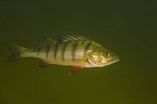(Press-News.org) Anxiety-moderating drugs that reach waterways via wastewater create fearless and asocial fish that eat more quickly than normal. These behavioral changes can have serious ecological consequences. This is shown by Umeå University researchers in the prestigious journal Science.
Many drugs leave our bodies unaffected, and residues from them are therefore found in wastewater. Low concentrations of drugs are often found downstream from sewage treatment plants. Today we test how dangerous drugs are to humans, but our knowledge of the environmental impacts of drugs is limited. For the first time, scientists have now been able to show how the behavior of fish is affected by involuntary medication.
Researchers have examined how perch behave when they are exposed to the anxiety-moderating drug Oxazepam. The changes were obvious in drug concentrations corresponding to those found in waters in densely populated areas in Sweden.
"Normally, perch are shy and hunt in schools. This is a known strategy for survival and growth. But those who swim in Oxazepam became considerably bolder," explains ecologist Tomas Brodin, lead author of the article.
The drug made the fish braver and less social. This means that they left their schools to look for food on their own, a behavior that can be risky, as school formation is a key defense against being eaten by predatory fish.
The fish also ate more quickly. Since fish fulfill an important function in many aquatic environments, changes in eating behavior can seriously disturb the ecological balance.
"We're now going to examine what consequences this might have. In waters where fish begin to eat more efficiently, this can affect the composition of species, for example, and ultimately lead to unexpected effects, such as increased risk of algal blooming," says Tomas Brodin.
Considerably more drugs with the same function are found in surface water downstream from sewage treatment plants, not only in Sweden but also elsewhere in the world. Moreover, drug use is predicted to increase. This means that previously unknown changes in behavior among fish, with ecological consequences as a result, may be a global phenomenon.
"The solution to the problem is not to stop medicating ill people but to try to develop sewage treatment plants that can capture environmentally hazardous drugs," says environmental chemist Jerker Fick.
The study, published in Friday's edition of Science, should be seen as a pointer about what might already be underway in many waters around the world. More comprehensive studies are required before any far-reaching conclusions can be drawn.
The scientists are presenting their findings at a press conference arranged by Science at the scientific conference AAAS Annual Meeting in Boston on February 14.
INFORMATION:
Original article:
The scientific article can be requested via Science, e-post: scipak@aaas.org
For more information, please contact:
Tomas Brodin, Department of Ecology and Environmental Sciences
Phone: +46 (0)90- 786 56 01, mobile: +46 (0)70-278 35 70.
E-mail: tomas.brodin@emg.umu.se
Jerker Fick, Department of Chemistry
Phone: +46 (0)90-786 93 24, mobile: +46 (0)70-261 65 56.
E-mail: jerker.fick@chem.umu.se
Micael Jonsson, Department of Ecology and Environmental Sciences
Phone: +46 (0)90- 786 77 18, mobile +46 (0)70-643 22 67.
E-mail: micael.jonsson@emg.umu.se
Jonatan Klaminder, Department of Ecology and Environmental Sciences
Phone: +46 (0)786 95 54, mobile: +46 (0)702-341 868.
E-mail: jonatan.klaminder@emg.umu.se
Fish become bolder and more gluttonous from drug residue
The behavioral changes can have serious ecological consequences
2013-02-15
ELSE PRESS RELEASES FROM THIS DATE:
Mood-modifying drugs for humans also alter fish behavior
2013-02-15
Pharmaceutical drugs that end up in the world's waterways after being excreted, flushed and treated at wastewater treatment plants may lead to unexpected ecological impacts, according to a new study of wild European perch. Tomas Brodin and colleagues from Umeå University in Sweden discovered that the fish ate faster, became bolder and acted less social after being subjected to an anxiety-moderating drug, known as Oxazepam.
The psychiatric drug is used to treat anxiety in humans. But, Oxazepam residues often wind up in natural aquatic systems, downstream from sewage treatment ...
Proof: Cosmic rays come from exploding stars
2013-02-15
Menlo Park, Calif. — A new study confirms what scientists have long suspected: Cosmic rays – energetic particles that pelt Earth from all directions – are born in the violent aftermath of supernovas, exploding stars throughout the galaxy.
A research team led by scientists at the Kavli Institute for Particle Astrophysics and Cosmology at the Department of Energy's (DOE) SLAC National Accelerator Laboratory sifted through four years of data from NASA's Fermi Gamma-ray Space Telescope to find the first unambiguous evidence of how cosmic rays are born.
Reporting in the ...
Rapid changes in the Arctic ecosystem during ice minimum in summer 2012
2013-02-15
This press release is available in German.
Bremerhaven, 14 February 2013. Huge quantities of algae are growing on the underside of sea ice in the Central Arctic: in 2012 the ice algae Melosira arctica was responsible for almost half the primary production in this area. When the ice melts, as was the case during the ice minimum in 2012, these algae sink rapidly to the bottom of the sea at a depth of several thousands of metres. Deep sea animals such as sea cucumbers and brittle stars feed on the algae, and bacteria metabolise what's left, consuming the oxygen in the ...
Study of insomnia finds a new predictor for suicidal thoughts
2013-02-15
DARIEN, IL – A new study confirms a link between insomnia and thoughts of suicide and suggests that this relationship is mediated by dysfunctional beliefs and attitudes about sleep as well as nightmares. The study suggests that the targeted assessment and treatment of specific sleep problems may reduce the risk of suicide in people with depressive symptoms.
"Insomnia and nightmares, which are often confused and go hand-in-hand, are known risk factors for suicide but just how they contribute was unknown," said Dr. W. Vaughn McCall, the study's lead author and chair of ...
Trolls win: Rude blog comments dim the allure of science online
2013-02-15
BOSTON – The trolls are winning.
Pick a story about some aspect of science, any story, scroll down to the blog comments and let the bashing begin:
"Wonder how much taxpayer cash went into this 'deep' study?"
"I think you can take all these studies by pointy headed scientists, 99 percent of whom are socialists and communists, and stick them where the sun don't shine."
"Yawn. Climate change myth wackos at it again."
"This article is 100 percent propaganda crapola."
"Speaking of dolts, if you were around in the 70s, when they also had scientists, the big talk ...
The role of radical prostatectomy in patients with prostate cancer
2013-02-15
Even in the presence of screening, there is benefit to radical prostatectomy (RP) in prostate cancer patients, however, the benefit is limited to a subgroup of patients and can take years to become evident according to a study published February 14 in the Journal of the National Cancer Institute.
The Scandinavian Prostate Cancer Group Study Number 4 (SPCG-4) trial identified that RP lowered prostate cancer deaths with a statistically significant absolute mortality difference (AMD) between RP and watchful waiting (WW) of 6.1%. The Prostate Cancer Intervention Versus Observation ...
The human pathogen Streptococcus pneumonia shields foreign DNA derived from other bacteria to promote genetic diversity and vaccine evasion
2013-02-15
FINANCIAL DISCLOSURE: CJ was funded by a grant from the Agence Nationale de la Recherche (projet n_ BLAN06-3_141806). The funders had no role in study design, data collection and analysis, decision to publish, or preparation of the manuscript.
COMPETING INTEREST: The authors have declared that no competing interests exist.
PLEASE ADD THIS LINK TO THE PUBLISHED ARTICLE IN ONLINE VERSIONS OF YOUR REPORT:
http://dx.plos.org/10.1371/journal.ppat.1003178
(link will go live upon embargo lift)
CITATION: Johnston C, Martin B, Granadel C, Polard P, Claverys J-P (2013) Programmed ...
Study shows alcohol consumption is a leading preventable cause of cancer death in the US
2013-02-15
(Boston) – Researchers from the Boston University School of Medicine (BUSM) and Boston University School of Public Health (BUSPH) have shown that alcohol is a major contributor to cancer deaths and years of potential life lost. These findings, published in the April 2013 issue of the American Journal of Public Health, also show that reducing alcohol consumption is an important cancer prevention strategy as alcohol is a known carcinogen even when consumed in small quantities.
Previous studies consistently have shown that alcohol consumption is a significant risk factor ...
Johns Hopkins researchers create new air sacs in mouse model of emphysema using novel growth factor
2013-02-15
In a study of mice, researchers at Johns Hopkins have identified a new molecular pathway involved in the growth of tiny air sacs called alveoli that are crucial for breathing. The scientists say their experiments may lead to the first successful treatments to regrow the air sacs in people who suffer from diseases such as emphysema in which the air sacs have been destroyed by years of smoking. The work may also suggest new therapy for premature infants born before their lungs are fully developed.
"One of the most daunting challenges we face as physicians is helping patients ...
U of M researchers find that doula care for low-income women could save taxpayers money
2013-02-15
MINNEAPOLIS / ST. PAUL (EMBARGOED UNTIL February 14, 2013) – New research from the University of Minnesota's School of Public Health has found lower cesarean birth rates among Medicaid beneficiaries with access to support from a birth doula than among Medicaid patients nationally. A doula is not a medical provider, but is a trained, experienced professional person who can provide information, physical assistance and support to a woman during childbirth.
The research indicates that policy changes to provide Medicaid coverage for birth doulas may actually decrease costs ...
LAST 30 PRESS RELEASES:
Norbert Holtkamp appointed director of Fermi National Accelerator Laboratory
New agentic AI platform accelerates advanced optics design
Biologists discover neurons use physical signals — not electricity — to stabilize communication
Researchers discover that a hormone can access the brain by hitchhiking
University of Oklahoma researcher awarded funding to pursue AI-powered material design
Exploring how the visual system recovers following injury
Support for parents with infants at pediatric check-ups leads to better reading and math skills in elementary school
Kids’ behavioral health is a growing share of family health costs
Day & night: Cancer disrupts the brain’s natural rhythm
COVID-19 vaccination significantly reduces risk to pregnant women and baby
The role of vaccination in maternal and perinatal outcomes associated with COVID-19 in pregnancy
Mayo Clinic smartwatch system helps parents shorten and defuse children's severe tantrums early
Behavioral health spending spikes to 40% of all children’s health expenditures, nearly doubling in a decade
Digital cognitive behavioral treatment for generalized anxiety disorder
Expenditures for pediatric behavioral health care over time and estimated family financial burden
Air conditioning in nursing homes and mortality during extreme heat
The Alps to lose a record number of glaciers in the next decade
What makes a good proton conductor?
New science reporting guide published for journalists in Bulgaria
New international study reveals major survival gaps among children with cancer
New science reporting guide published for journalists in Turkey
Scientists develop a smarter mRNA therapy that knows which cells to target
Neuroanatomy-informed brain–machine hybrid intelligence for robust acoustic target detection
Eight SwRI hydrogen projects funded by ENERGYWERX
The Lundquist Institute and its start-up company Vitalex Biosciences Announces Strategic Advancement of Second-Generation fungal Vaccine VXV-01 through Phase 1 Trials under $40 Million Competitive Con
Fine particles in pollution are associated with early signs of autoimmune disease
Review article | Towards a Global Ground-Based Earth Observatory (GGBEO): Leveraging existing systems and networks
Penn and UMich create world’s smallest programmable, autonomous robots
Cleveland researchers launch first major study to address ‘hidden performance killer’ in athletes
To connect across politics, try saying what you oppose
[Press-News.org] Fish become bolder and more gluttonous from drug residueThe behavioral changes can have serious ecological consequences


